Riding Bolinas Ridge Trail today. It is listed #28 on
Mountain Biking Northern California's Best 100 Trails.
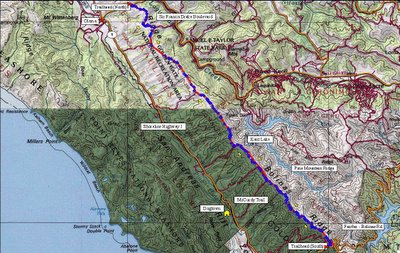
Map and route of Bolinas Ridge Trail. 250 track points laid by the
GPS unit.
 TOPO!
TOPO!'s elevation profile.

Northern trailhead off Sir Francis Drake Boulevard. Started at 11 AM. Temperature was 46 F (7.7 C), without taking windchill into account. Discovered to my chagrin that I left my
vest back at the hostel. Grrr. Thank goodness for my windbreaker.

Wider view. It is a sight to behold when the coastal fog blows in.

Trail sign.

Trail warning. Now I know why some cranky cows on
Bull Point Trail refused to yield and tried to headbutt me instead.

Gentle climbs over pastureland. On the right, cows in the distance.

After the 1st brief climb. This spot reminds me of New Zealand's South Island: beautiful, isolated, secretive, and subject to the vagaries and whims of micro-climates.

2nd climb. Though it gets steeper near the top, it isn't as long a climb as it looks. Or maybe it's just that I had a good breakfast and am full of energy...

Elevation approximately 914 feet: a pond at the foot of a knoll on this ridge.
Back in Santa Clara, as I am composing this write up, an old man hobbled on the sidewalk, past my window, trailing his oxygen tank behind him on a dolly. The
soundtrack to the
film adaptation of Kazuo Ishiguro's
The Remains of the Day is playing on my
sound system. The sight of the geriatric, the melancholy music, coupled with the approaching twilight, make me think about how little time we have on this earth to appreciate her ineffable beauty and august majesty. We are here for a while, and then we are gone. How little time to stroll, to bike, to hike, to climb, and leap with the impunity of youth, the ignorant audacity of naivete, in forests, mountains, canyons, across streams and rivers, before we are wrack and bent by time, and hobble, half-blind, wheezing and hacking to our graves.
I guess I am selfish in that way — I will not sacrifice my youth, my health, my wealth for someone's so-called greater cause. I will be no one's beast of burden: financial, intellectual, spiritual or otherwise. Look somewhere else for your martyrs (or coolies: cyber or otherwise). This ship has its own captain, and he only follows his own orders. Go rehearse your timeshare sales pitch somewhere else.

Climbed up the knoll by the pond. Looking back where I came from. The ridge I am standing on is Bolinas Ridge. The ridge directly across is Inverness Ridge. Behind it is the Pacific Ocean. The valley between these two ridges is Olema Valley. The active
San Andreas Fault / Rift lurks under idyllic
Olema Valley.

Leaving pasture land and skirting the edge of the forest. Spotted a herd of
Fallow deer in the distance, but they dashed away before I could get close enough with my camera.
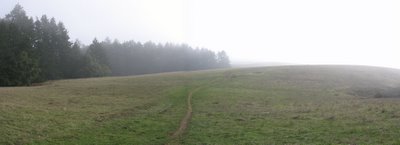
Trail flanking the forest.

Trail entering forest.

Wider view.

Looking back.

A popular resting spot.

A wider view.

Entering protected area: Mount Tamalpais Watershed.

Entering Lothlorien. A
Bobcat (Felis rufus) ran across the trail in front of me. It looked like a large, spotted kitten with a short, stubby tail.

The rush of the wind through the forest is punctuated by the pitter-patter of water dripping down to the ground below. But it is not rain. The water comes from fog condensing on leaves and Spanish moss, gaining mass, and then dripping off. The process is called fog drip.
In some instances the dripping is as heavy as light rain, as sometimes occurs among the redwood trees along the coast of northern California. During the foggy but almost rainless summers of California, fog drip prevents an excessive aridity in the coastal forests. As much as 0.05 in. of water, equivalent to a moderate shower, has been collected from a California fog in a single night. (
Source)

A close up picture of a piece of Spanish moss that has fallen to the ground. It has no roots. It derives water solely from fog and dew. The strips are eucalyptus bark.

Another close up of Spanish moss, this time hanging off a tree.
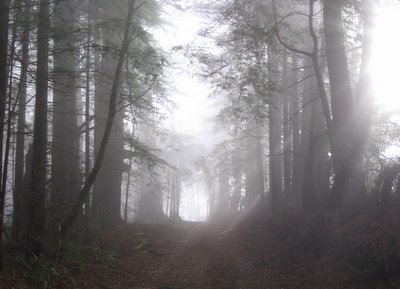
Inside the forest, the temperature is cooler, ranging from 37 to 39 F (2.7 C to 3.8 C), but there was no wind, so it evens out (unless you are blasting downhill on the return trip).

Words are inadequate in describing the experience of riding through this: I am bathed in light, and white, luminous fog; each full breath — powering every revolution of the wheels over the velvety-soft carpet of leaves — is steeped with the mingling, shifting scents of pine, redwood, douglas fir, and eucalyptus. I am moving, and yet the white, translucent air that I breathe is moving as well. I am utterly alone in this foggy forest, on this windswept ridge, on this misty mountain.
I don't want to get to the end of my life and find that I have just lived the length of it. I want to have lived the width of it as well. (Diane Ackerman)

Going deeper into the forest.

And deeper.

And deeper.

A clearing. I had to pinch myself several times to make sure the sight was real.

Close up.

McCurdy Trail connection. Woodville is another name for
Dogtown. The trail drops 1180 ft in 1.8 miles to Dogtown.

3.4 miles to Fairfax - Bolinas Road.

A long 3.4 miles as I found out. Check out the magnified section on the right: 992 feet of climbing with an average grade of 10%. It felt steeper with the ruts, loose rocks and slippery tree roots though.

Exited the forest. Beginning a 250 feet rolling descent down to the southern trailhead of Bolinas Ridge Trailhead at Fairfax - Bolinas Road.

Looking back after having left the forest. Notice the change in vegetation from forest to chaparral.

More rollers and 2 rutted downhills later: the southern end of the Bolinas Ridge Trail, at the sinuous Fairfax - Bolinas Road.
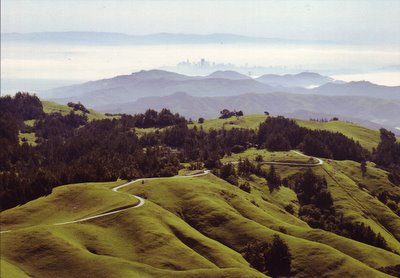
An aerial photograph. To the east, Fairfax - Bolinas Road snakes towards Fairfax in an
endless series of hairpin turns. To the west, it drops 1500 ft to
Stinson Beach in 5 miles. Bolinas Ridge continues southeastwards along the flanks of
Mount Tamalpais and towards the
Marin Headlands, with the very pretty West Ridgecrest Boulevard (above) running on top of it. Across the bay, San Francisco and her landmarks (e.g.
Transamerica Pyramid) shimmer in the distance. Trivia: West Ridgecrest Boulevard is commonly used for filming automobile commercials.

What the sign says: 11.3 miles (18.08 km) to get back to the Bolinas Ridge Trailhead at Sir Francis Drake Boulevard (where I parked my car).

Back on the chaparral ridge, just before re-entering the forest, looking east: fog totally covering Kent Lake (elevation 500 ft) between Bolinas Ridge and Pine Mountain Ridge (elevation 1762 ft).
Pine Mountain looks like an island now.

A closer look.
Zoomed in. While nearby
Mount Tamalpais (1) is generally recognized as the historic birthplace of the sport of mountain biking: the steeper and looser slopes of Pine Mountain Ridge and Pine Mountain were likely to be more instrumental in driving the evolution of early mountain bikes from single-speed to the multiple gearing systems we encounter today.

Leaving the forest towards open pasture land.
Bush rabbits (Sylvilagus bachmani) and the occasional
Black-tailed Jack rabbit (Lepus californiacus) hop out of my way as I bombed down the ridge. Trivia: When the Black-tailed Jack rabbit is running at moderate speed, every fourth or fifth hop is higher, allowing for a better view of the surrounding area.

One more cattle gate to cross.

One more climb into the fog. And a rollicking good time bombing down the rest of the ridge back to the car.
The trail is isolated on weekdays. I met no one during the entire ride, save for a trio of ill-prepared novice mountain bikers on the last 2 miles of the ride who asked to borrow my pump.
Epilogue:
Total distance: cyclo-computer 22.8 miles (36.48 km) /
GPS 22.43 miles (35.89 km) /
TOPO! 22.50 miles (36 km).
Total elevation climbed: Altimeter 3350 ft (1021.3 m) /
GPS +
TOPO! 3317 ft (1011.28 m).
Temperature range: 37 F to 46 F (2.8 C to 7.8 C).
Fluids consumed: 1 liter.
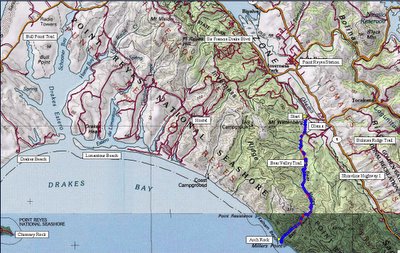 Map of the ride. 238 track points laid down by the GPS unit.
Map of the ride. 238 track points laid down by the GPS unit. TOPO!'s elevation profile.
TOPO!'s elevation profile.  Rigging up in the parking lot. It's 44 F (6.6 C) and it's windy and it's raining. But my cycling socks give me inspiration.
Rigging up in the parking lot. It's 44 F (6.6 C) and it's windy and it's raining. But my cycling socks give me inspiration. Map at trailhead.
Map at trailhead. Bear Valley Trailhead.
Bear Valley Trailhead.  A gentle climb to 368 ft. Helps to keep one warm too. An Ent guards the road on the right. (Look closely, doesn't it resemble a human face?)
A gentle climb to 368 ft. Helps to keep one warm too. An Ent guards the road on the right. (Look closely, doesn't it resemble a human face?) Fallow deer (Cervus dama), at Divide Meadow. Fallow deer are common in bushy hillsides and grassy fields. Their color vary from white to light brown to blackish-brown, with some possessing distinctive spots through adulthood. Their antlers have wide, flatten palms. Fallow deer are native to Asia Minor and the Mediterranean region. They were introduced by hunters, who favored the white variety as it made them easier to spot (and shoot). Looking at the bad picture (sorry, it's foggy and it's raining), how many blackish-brown and light brown deer can you see? What about the white deer?
Fallow deer (Cervus dama), at Divide Meadow. Fallow deer are common in bushy hillsides and grassy fields. Their color vary from white to light brown to blackish-brown, with some possessing distinctive spots through adulthood. Their antlers have wide, flatten palms. Fallow deer are native to Asia Minor and the Mediterranean region. They were introduced by hunters, who favored the white variety as it made them easier to spot (and shoot). Looking at the bad picture (sorry, it's foggy and it's raining), how many blackish-brown and light brown deer can you see? What about the white deer? Bike rack. The final 1 mile (1.6 km) has to be made on foot.
Bike rack. The final 1 mile (1.6 km) has to be made on foot. Fenders would have been a good idea.
Fenders would have been a good idea. That's not just mud all over my bike, on my seat, my butt and back (not pictured). You see, the rain mixes horse crap, deer droppings, rabbit pellets, and fox poo with mud. And when a spinning tire goes over it... You get the idea.
That's not just mud all over my bike, on my seat, my butt and back (not pictured). You see, the rain mixes horse crap, deer droppings, rabbit pellets, and fox poo with mud. And when a spinning tire goes over it... You get the idea. Moi.
Moi. Trail sign.
Trail sign. That little sign carries a lot of weight. Trail poaching ("illegal riding") here results in a fine in the hundreds of dollars and the confiscation of your bike.
That little sign carries a lot of weight. Trail poaching ("illegal riding") here results in a fine in the hundreds of dollars and the confiscation of your bike. Entering Fangorn Forest. The cool dampness from the fog, mist, rain and dew results in a type of verdant growth that is distinct from tropical jungles. It is colder in here, about 39 F (3.8 C).
Entering Fangorn Forest. The cool dampness from the fog, mist, rain and dew results in a type of verdant growth that is distinct from tropical jungles. It is colder in here, about 39 F (3.8 C). Reaching the coastal area and leaving the forest. The rain stopped--temporarily.
Reaching the coastal area and leaving the forest. The rain stopped--temporarily. Ground becoming more sandy underfoot. Forest has given way to coastal scrub.
Ground becoming more sandy underfoot. Forest has given way to coastal scrub. Reaching Arch Rock.
Reaching Arch Rock. Wide view.
Wide view. Final approach.
Final approach. Looking south at Millers Point.
Looking south at Millers Point. Closer view.
Closer view. View from the top of Arch Rock. Storm clouds returning. Rain will resume shortly.
View from the top of Arch Rock. Storm clouds returning. Rain will resume shortly. View north.
View north. Coast Creek drains into the Pacific, cutting a canyon into the rock.
Coast Creek drains into the Pacific, cutting a canyon into the rock. A couple of hikers contemplating the scramble down the canyon.
A couple of hikers contemplating the scramble down the canyon. This spot marks the terminus of Coast Creek. Standing on the sand enables one to look through the arch at the bottom of Arch Rock, but it is a treacherous exercise: a big wave could wash in at any time and suck one out to the ocean. The steep canyon walls mean there isn't much room to run as well.
This spot marks the terminus of Coast Creek. Standing on the sand enables one to look through the arch at the bottom of Arch Rock, but it is a treacherous exercise: a big wave could wash in at any time and suck one out to the ocean. The steep canyon walls mean there isn't much room to run as well. The Pacific rushes in through here to embrace the freshwater of Coast Creek.
The Pacific rushes in through here to embrace the freshwater of Coast Creek.  Looking through the bottom of Arch Rock.
Looking through the bottom of Arch Rock. Returning to the forest (and fog and rain). The ride back to the car was a cold cruise downhill at 22.4 mph (35.84 km/h) in the rain and 40 F (4.4 C).
Returning to the forest (and fog and rain). The ride back to the car was a cold cruise downhill at 22.4 mph (35.84 km/h) in the rain and 40 F (4.4 C).









































